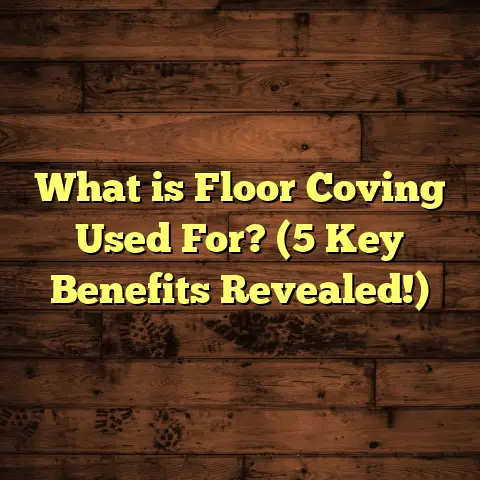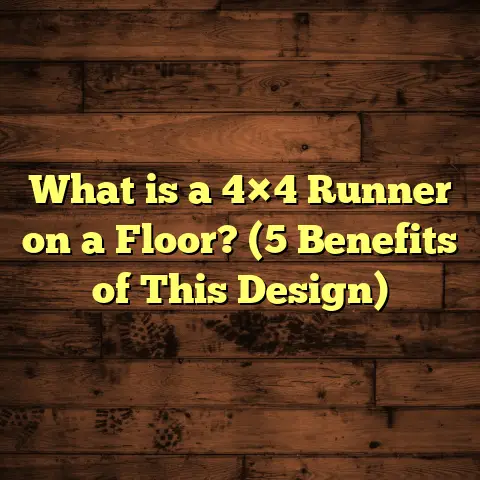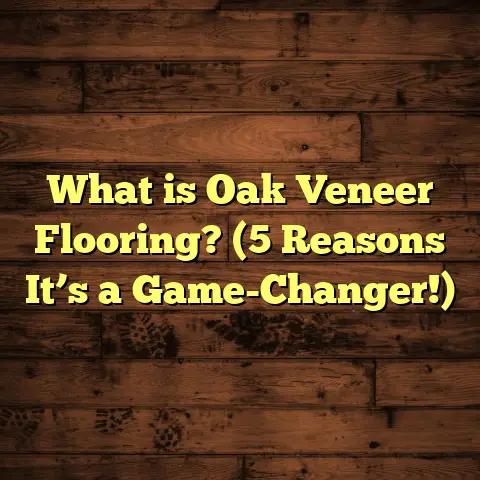What is the Cheapest Flooring Option? (5 Budget-Friendly Choices)
Have you ever found yourself standing in a flooring store, overwhelmed by endless options, colors, and materials? I know I have. Trying to pick the right flooring without overspending feels like walking a tightrope. You want a floor that looks good, lasts long enough, and won’t drain your savings. So naturally, you ask: What is the cheapest flooring option? Which one gives me the most bang for my buck without turning into a headache later?
I’ve been in the flooring business long enough to see all sorts of projects—from high-end hardwood installs to budget-friendly renovations. Over time, I learned that “cheap” flooring isn’t about going for the absolute lowest price. It’s about balancing cost, durability, style, and ease of installation. Some materials surprise you with their value when you understand their pros and cons.
Let me take you through five popular budget-friendly flooring choices I’ve installed or recommended many times. I’ll share my personal stories, real cost numbers, what worked well, and what to watch out for. By the end of this deep dive, you’ll have clear insight on which cheap flooring might suit your home best.
What is the Cheapest Flooring Option?
When we talk about the cheapest flooring option, it means flooring materials that are low-cost upfront and don’t require expensive installations or maintenance. Price per square foot is usually the first thing people think about—but don’t forget labor costs and lifespan.
Some of the most affordable materials include:
- Vinyl (both sheets and luxury vinyl planks)
- Laminate flooring
- Carpet (especially low-pile or commercial-grade)
- Ceramic tile (basic styles)
- Engineered wood alternatives
Each has a different balance of price, durability, comfort, and visual appeal.
How I Define “Cheap” Flooring
For me, cheap flooring isn’t about picking the absolute cheapest product on the shelf. It’s about good value—a floor that:
- Costs less than $5 per square foot total installed (material + labor)
- Lasts at least 10 years without major repairs
- Looks decent or better
- Is easy to maintain for most homeowners
I found that floors below this threshold often sacrifice too much quality or longevity. But within this range, you can find smart options.
Why Cost Matters But Isn’t Everything
When I first started installing floors years ago, I focused purely on material cost. But over time I realized cheap materials with poor durability often lead to higher costs down the road—repairs, replacements, damage to subfloors.
For example, a $1 per square foot vinyl floor that lasts 15 years offers better long-term value than a $0.50 per square foot carpet that needs replacement every 5 years.
So I always encourage people to think about lifetime cost, not just upfront price.
1. Vinyl Flooring – The Budget Workhorse
Vinyl flooring has been a go-to for budget-conscious homeowners for decades—and for good reason. It’s affordable, versatile, and surprisingly sturdy.
My Vinyl Flooring Story
I remember one project where a family wanted to renovate their kitchen on a tight budget. They didn’t want to tear up the subfloor or deal with moisture issues in their old home. Vinyl planks fit perfectly—the installation took just a couple of days, and they got the look of hardwood for a fraction of the price.
Months later, they told me how easy it was to clean and how well it held up despite kids and pets running around.
What Makes Vinyl So Affordable?
Material costs for vinyl vary depending on type:
- Sheet vinyl: $0.50 to $2 per sq ft
- Luxury vinyl planks (LVP): $2 to $4 per sq ft
Installation is generally simple;DIYers can do it with basic tools, or professionals charge $1-$2 per sq ft.
Durability & Maintenance
Vinyl is water-resistant to waterproof (especially LVP), making it ideal for kitchens, bathrooms, basements. It stands up well to spills and stains.
The average lifespan is 10-20 years depending on quality and wear.
Maintenance is easy—regular sweeping and mopping keeps it looking fresh.
Stats & Industry Data
- The U.S. flooring market shows vinyl growing 5% annually due to affordability and durability.
- Consumer surveys reveal vinyl ranks #1 for satisfaction in budget floors.
- According to manufacturers’ warranties, high-quality vinyl can last 15+ years even in medium traffic areas.
How I Use FloorTally for Vinyl Projects
When planning vinyl installs today I plug in local prices into FloorTally. It calculates material plus labor costs based on square footage and adds waste factors so I order just enough supplies without overbuying. This saves money and helps clients stick to budgets.
2. Laminate Flooring – Stylish Yet Wallet-Friendly
Laminate flooring mimics hardwood’s look but at a lower price point.
My Experience With Laminate
I installed laminate floors in a few rental properties where landlords wanted an affordable way to upgrade interiors without major risk of damage from tenants.
Laminate was ideal because it clicks together easily over existing floors and stands up reasonably well to scratches.
Cost Breakdown
Materials typically run between $1-$3 per sq ft depending on brand and thickness.
Professional installation averages $1-$2 per sq ft; DIY is possible but requires careful subfloor prep.
Pros & Cons
Laminate offers a wide range of wood-look options at low cost with decent durability against scratches.
However, it’s not as water-resistant as vinyl—spills must be cleaned quickly to avoid damage unless you choose waterproof varieties that cost more.
Durability & Maintenance
Laminate can last 15-25 years if kept dry.
It resists stains and scratches better than carpet or vinyl but doesn’t handle moisture well.
You clean laminate floors with dry mops or damp cloths; avoid soaking them.
3. Carpet – Soft & Comfortable Budget Option
Carpet often gets overlooked when thinking “cheap flooring,” but in certain rooms it’s both affordable and practical.
My Carpet Story
A couple years back I helped a family swap their worn hardwood upstairs with carpet because kids wanted softer floors to play on.
They had a modest budget but still wanted something durable enough for high traffic areas like hallways and bedrooms.
Cost Details
Basic carpet materials range from $1-$5 per sq ft depending on fiber type and density.
Installation usually adds another $1-$3 per sq ft.
Low-pile or commercial-grade carpets are among the cheapest types available—great for rental units or guest rooms but less plush feeling.
Longevity & Care
Carpet tends to last 5-15 years depending on quality and foot traffic.
Routine vacuuming is essential; deep cleaning every 12-18 months helps maintain freshness.
It also provides sound insulation and warmth that hard floors don’t offer.
4. Ceramic Tile – Affordable When Planned Well
Ceramic tile is often seen as pricey but can be budget-friendly if you pick simple designs and install yourself.
My Tile Installation Experience
I tackled a small bathroom remodel where we used basic ceramic tiles costing under $1 per sq ft from clearance sales combined with DIY installation. Total costs were under $5/sq ft including grout and labor saved by doing it myself.
Cost Breakdown
Tile material costs vary widely:
- Basic ceramic tiles: $0.50-$3 per sq ft
- Installation by pros: $4-$8 per sq ft (can be high)
If you can DIY or hire a good tiler with reasonable rates, tile can fit tight budgets especially in small rooms or entryways.
Durability & Maintenance
Tile is extremely durable—lasting over 30 years if cared for properly—and water-resistant making it ideal for bathrooms/kitchens.
Grout cleaning can be a chore but sealing grout reduces stains and buildup.
5. Engineered Wood Alternatives – Affordable Real Wood Feel
Engineered wood offers a wood veneer over plywood backing at lower prices than solid hardwood floors.
My Experience Installing Engineered Wood
One homeowner wanted hardwood look but couldn’t afford solid oak throughout their home. We went with engineered wood planks that looked authentic and installed quickly over concrete slabs where regular hardwood wasn’t an option.
Price Range & Installation Costs
Materials typically cost between $3-$7 per sq ft depending on wood species and thickness of veneer layer.
Installation runs $3-$5 per sq ft professionally; floating floor systems may allow DIY installation.
Durability Insights
Engineered wood lasts 15-25 years if maintained well—less prone to warping than solid wood in humid conditions.
Can be refinished once or twice depending on veneer thickness but not as many times as solid hardwood.
Comparing Costs: A Practical Case Study from My Projects
To give you some context on how these costs add up, here’s a breakdown from recent projects I completed:
| Flooring Type | Material Cost (per sq ft) | Installation Cost | Total Cost (for 500 sq ft) | Lifespan (Years) |
|---|---|---|---|---|
| Vinyl Plank | $2 | $1.50 | $1,750 | 15 |
| Laminate | $2 | $1.50 | $1,750 | 20 |
| Carpet | $3 | $2 | $2,500 | 10 |
| Ceramic Tile | $1 | $5 | $3,000 | 30+ |
| Engineered Wood | $5 | $4 | $4,500 | 20 |
From this data, vinyl and laminate are clearly most affordable for large areas when factoring in labor. Carpet sits in the middle with softness benefits but shorter lifespan. Tile can cost more upfront due to labor but lasts longest. Engineered wood is pricier but offers real wood aesthetics at discount compared to solid hardwood.
Why Using Tools Like FloorTally Makes Life Easier
I can’t stress enough how much tools like FloorTally help me plan these projects efficiently. Instead of guessing quantities or calling multiple suppliers for quotes—which takes hours—I input dimensions and preferences into FloorTally. It spits out detailed estimates including:
- Local material prices
- Labor charges based on my region
- Waste percentages so I don’t overbuy
- Total project costs side-by-side for different floor types
This way clients know exactly what to expect financially before we start demolition or ordering materials. It’s saved me from costly mistakes multiple times when managing budgets tight as mine always are!
Maintenance Tips That Keep Cheap Floors Looking Great Longer
Choosing cheap flooring doesn’t mean you neglect upkeep! Here’s what I always recommend to my clients:
- Vinyl: Sweep often; mop with gentle cleaner; avoid abrasive scrubbing.
- Laminate: Clean dry or slightly damp; wipe spills immediately.
- Carpet: Vacuum regularly; deep clean yearly; spot treat stains fast.
- Tile: Seal grout annually; sweep dirt off tiles; mop with pH-neutral cleaner.
- Engineered Wood: Use wood floor cleaner; avoid excess water; protect from scratches with felt pads under furniture.
Good maintenance extends life far beyond average estimates—making your cheap floor last like an expensive one!
Final Thoughts on Budget Floors From Someone Who’s Seen It All
Choosing cheap flooring options doesn’t mean settling for “just okay.” With some knowledge and planning, you can find affordable floors that look great, last long enough for your needs, and don’t drain your wallet unexpectedly later.
Vinyl comes out as my personal favorite overall for budget projects due to its balance of price, durability, ease of installation, and moisture resistance. But laminate also has strong points if you want more scratch resistance or wood-like feel without high cost.
Carpet is great when softness counts more than durability—perfect for kids’ rooms or basements. Ceramic tile rewards patience through DIY installation with long-lasting beauty especially in moisture-prone spaces. Engineered wood lets you enjoy real wood aesthetics without hardwood costs but may not fit tightest budgets.
If you ever find yourself stuck calculating costs or unsure which floor fits your budget best—as I often do—try tools like FloorTally for quick estimates tailored to your location and project size. It makes choosing flooring easier and keeps surprises out of your renovation plans.
Got questions about specific materials? Need help estimating your project? Just ask—I’m always happy to share what I’ve learned from years of flooring work!





